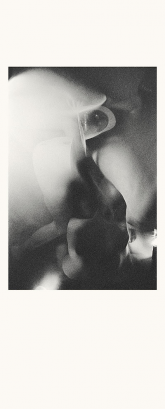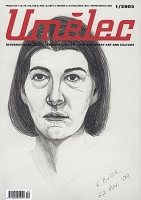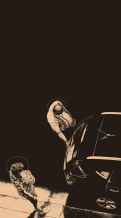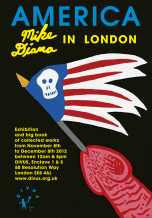| Zeitschrift Umělec 2005/1 >> Voluntary Invisibility? | Übersicht aller Ausgaben | ||||||||||||
|
|||||||||||||
Voluntary Invisibility?Zeitschrift Umělec 2005/101.01.2005 Věra Sokolová | theory | en cs |
|||||||||||||
|
Visual Arts and Lesbian Identity
There have always been artists who are lesbians. There have always been lesbians who make art. Putting aside debates about whether it is possible to call lesbians women, who had desired or loved other women before the modern category of a lesbian was established in the end of the 19th century, there have always been “lesbian artists.” However, definitions and categories cannot be entirely used at will. The terms “lesbian art” and “lesbian artist” are primarily associated to the 1960s and 1970s, when feminist, civil rights and gay and lesbian movements struggled for the recognition of their rights to equal opportunity and treatment in the US and Western Europe. New social identities came to life, accompanied by new political demands and intellectual directions. Art, including the visual arts, was at the vanguard of articulating those new political positions and critiques of society. Lesbian artists working at that time reflected in their work their own view of the world and lived experiences that mirrored the history of sexual regulation in society. They thus directly influenced the ways in which lesbians could live their lives. These specific viewpoints and lived experiences were necessarily projected into their artistic perceptions, artistic mediums and conceptual angles, whether manifested in realistic or abstract painting, sculpture, or photography. This is also the reason why the terms “lesbian art” or “lesbian artist” became an integral part of the conceptual and analytical apparatus of art criticism. Today, there is a relatively large number of academic and critical books published outside of the Czech Republic that are concerned with the representation of homosexuality in the visual arts, including lesbian art and artists. The first monograph from the 1980s to survey this genre was Sexual Politics: Homosexuality and Art in the Last 100 Years in the West. A Hidden Love: Art and Homosexuality and Pictures and Passions: A History of Homosexuality in the Visual Arts are also worth mentioning. In the early 1990s volumes exclusively focused on lesbian art began to emerge. Lesbian photographers Jean Fraser and the late Tessa Boffin published Stolen Glances: Lesbians Take Photographs and Lesbian Looks, both from 1991, which were followed by Forbidden Subjects: Self-Portraits by Lesbian Artists in 1994. The following year was marked by two additional publications, Butch/Femme and Paris Was A Woman, which were then followed by an avalanche of other monographs, anthologies, catalogs, calendars and comics. In 1996, Nothing But The Girl: The Blatant Lesbian Image, edited by Susie Bright and Jill Posener, published a defiant and eloquent collection of 150 black & white and color photographs of lesbian artists. Lesbian Art: An Encounter with Power, by Australian art historian Elizabeth Ashburn, is a complex treatment of the work of 55 lesbian artists, active in the course of the 1970s and 1980s. While Ashburn takes an in-depth look at visual art itself, Cherry Smyth, in her meticulously analyzed and argued Damn Fine Art by New Lesbian Artists, critically examines the politics of lesbian identity in the context of the visual arts by using the examples of 48 authors and two artistic groups. In 1999 and 2000, Della Grace, one of the most well-known lesbian photographers (known even better under the name Del Lagrace Volcano), published projects entitled The Drag King Book and Sublime Mutations. These books are focused primarily on the productions of American lesbian artists, complemented by British and Australian works. Books or authors from other countries have also sporadically appeared, such as the excellent monograph about the French Jewish photographer Claude Cahun, whose unique treatment of self-portraits became an inspiration for many subsequent artists (Claude Cahun, Photographe). In the Czech Republic, however, not a single academic or artistic volume has been published that would thematize or map contemporary lesbian art and/or lesbian artists. Art historian Martina Pachmanová confirms this situation: “I have to admit that I have specialized in modern art for a relatively long time, but in the Czech context I have not encountered the term ‘lesbian art.’ And I guess that in the Slovak environment the situation is similar.” Is it possible that there are no lesbian artists in the Czech Republic? Certainly not. What is missing is rather the interest – by art critics, audiences, but also the artists themselves – to ask such questions. In addition, there is also a general resentment against politicizing one’s identity, which is a direct consequence of the previous regime. Lesbians, who are artists, are certainly not absent in the Czech Republic. They create, exhibit, and sell their art. They work in TV, radio stations and art galleries. They are successful and famous – but not as lesbians. Their art is visible, but “lesbian art” remains a non-existent category in Czech visual culture. Czech artists, who identify as lesbians only in their private lives, have a tendency to support this absence and invisibility. The Czech art scene, for its part, does not reflect upon this absence and thus does not miss their presence. Pachmanová has aptly described both sides of this blind and limiting heterosexist equation, when she added that “to not openly admit one’s gay or lesbian identity is certainly easier in our society and it does not complicate one’s life. But I think it’s a shame. However, gay and lesbian artists somewhat participate in this themselves if they are not open because then they only help to reinforce the established mode of thinking that our art and culture is a heterosexual matter.” In November of last year, LeGaTo, the Czech gay and lesbian monthly television program, featured several gay and lesbian artists who spoke about their art in the context of their gay and lesbian identity. All of them claimed that they do not consider their art to be gay or lesbian, because they reject “labels” which seem limiting to them. Why is that? While in other countries exhibitions and books, working with the terms “lesbian art” and “lesbian artist,” regularly appear, we fulminate against “labels” before we even consider why we are so opposed to them. Are we so advanced in perceiving art without limits and modifiers? Or so behind that we are not yet able (or refuse to) reflect that art contains (even if implicit) hierarchies, author positions and gazes, from which some are more privileged than others? Lesbian art, or if you prefer, the work of lesbian artists, offers the opportunity to reverse the gaze of the traditional author, which has been historically male and heterosexual. Works of art created by lesbian artists have a potential to function as a mirror for audiences by forcing them to reflect on what they see in the artistic representation and why they see what they see (and the same can be said, of course, about both authors and viewers). What lesbian artists see through their lived experience certainly differs from the “ways of seeing” of heterosexual artists, both men and women. I interviewed several Czech lesbian visual artists, who are open about their identity, and asked them to examine – as artists and as lesbians – the “lesbian dimension” of their work and how they understand the term “lesbian art.” Photographer Jana Štěpánová considers the absence of lesbian artists on the Czech art scene a major problem. “In our society there are very few people who openly profess their gay or lesbian identity in connection to their artistic work. For some reason, it is more important to them to reject labels that designate them. Perhaps they fear that it will limit them to certain audiences. For me it’s the opposite. I feel it is important to say and show that being a lesbian is a part of my lived experience, and I don’t underestimate its influence. And there is no way I would hide my lesbian identity, for doing so would be going against who I am. I don’t work specifically for a lesbian audience. But that doesn’t mean that I’m not a lesbian or that I don’t work with lesbian material or my own experience. But the experience is mine. Another lesbian will perhaps have a completely different experience.” The fundamental question is, of course, what the modifier “lesbian” actually refers to. Is art lesbian because it is consumed by lesbians regardless of who created it? Or is it lesbian because it is created by a lesbian woman? Or is it lesbian because it works with some specific lesbian theme? Painter Věra Vampolová holds a similar view. “My work is without a doubt influenced by the way I live my life, which is emotionally and intellectually fulfilled by women. I believe that through some channels it simply must get into my work. The fundamental issue, however, is my artistic expression, how able I am to express myself. If I am a realistic painter and I decide that I want to tell and show people that I am a lesbian woman, that we exist, they all will see it there. But my themes and pictures are abstract. They are not so demonstratively readable for the public. But still, I don’t understand lesbians who cannot be open about their identity. It’s a shame, especially if they create good art. Then they just support the view that good artists must be heterosexual and the entirety of art is then perceived as heterosexual. There is fear, often an absurd one, that as soon as I say that I’m a lesbian, my art will not be considered good anymore. Many lesbians are afraid that it will limit them, that viewers will read lesbian themes into every aspect of their work, or they will from the onset decide they will not attend an exhibition because the author is a lesbian and they don’t care about that, it doesn’t concern them.” Painters Marcela Vichrová a Petra Fischerová first gave rather reserved answers, similar to the artists in LeGaTo. Subsequently, however, they elaborated their thoughts in a more complex way. “I probably don’t want to give it the label. To me, art is either true or empty,” says Vichrová. On the other hand, however, she feels that “even though with heterosexual artists we share the necessity and desire to create, we are different. We look at the world differently.” Fischerová also believes that “art is either good or bad. In my opinion, lesbian art doesn’t exist.” Immediately, though, she added the interesting thought that “for ‘lesbian art’ to have any meaning, the term would have to develop for at least a hundred years.” In her contemplation she compared the development of lesbian art to the development of ‘black art.’ “It took over a hundred years until the black artist achieved an equal position with the white artist. But he didn’t become great because he would be making black art. He didn’t exclaim ‘I’m making black art.’ He was making good art, but because he was black, his art was black.” This thought is not irrelevant. Thematization demands distance and reflection. Even though the work of lesbian artists has had a permanent place on the artistic scene of Western Europe and North America since the late 1960s, its break into book culture dates only to the mid 1990s. It took about 25 years until the photographer and essayist Tee Corrinne could enthusiastically account for this milestone in the perception of lesbian art. “Books are more influential than exhibitions,” she wrote. “They are like having portable art galleries with paper walls, publicly accessible, yet viewable in the safety of your own home.” In 2000, Lesbian Art in America was published, the first book that comprehensively considers the work of contemporary lesbian artists, focusing on when, where and in what contexts they showed their work and what reactions there were to their art. Its author, Harmony Hammond, a well-known and successful lesbian artist, curator and scholar, looked back at those thirty years and remarked that it is still “a hidden and missing history” of the history of art. The fear of labels, which lesbian artists seem to have, has its logic. In our culture there still prevails a notion that there is some universal art without modifiers, which is the real, authentic art gushing out from the depths of an artist’s soul without the politicized influences of and outside society. Often we hear objections that there is no heterosexual art, so why there should be any lesbian or gay art? Allegedly, heterosexual artists do not need to profess their sexuality by labeling their art as such. However, everything is about the positions from which we create, speak, write, perceive and see the world around us. It is not possible for an artist, whether heterosexual or homosexual, not to incorporate their sexual and gender identity into their art, because it is an inextricable part of their being. But not all identities have the same position. Vichrová and Vampolová agree that “lesbian experience brings a whole new dimension of looking at society,” which heterosexual artists simply cannot have because their personal worldview, in this aspect, concurs with the mainstream view. “Our seeing goes beyond the framework of social heterosexuality,” says Vampolová. The privilege of the heterosexual position rests precisely in that it is not necessary to thematize it. It is automatically presumed and thus normative. Social seeing and artistic representation of the surrounding world is implicitly heterosexual – unless it defines itself otherwise. This normative presumption contains many dimensions of power, which may not always be realized in their full depth. “Our art must be twice as good if we want to exhibit it as lesbians,” argues Fischerová. “We cannot just doodle up a woman and a rose and claim, ‘this is my lesbian art’; it has to have a hallmark of quality.” Vampolová opposes this view and asserts that production of lesbian artists definitely does not have to be better than the art of others. However, stress and social pressures prevent many lesbian artists from identifying their work as lesbian art. “When you want to be visible, you have to put your name on your work. Then you have to show your face. I don’t know if what I create counts as lesbian art, but I am a lesbian. And it is a risk. You never know how your surroundings will react. Most artists in the mainstream society work without this stress.” Vichrová also confirms that the pressure that she experiences as an artist is tied not so much to the art itself as to the social identity and the differing positions, which various artists have. “When I create, I feel free,” she says. “But as soon as I want to exhibit or sell, I immediately feel that my position as a woman is significantly worse than a position of a male artist. When people learn in addition that I’m a lesbian, it’s often discrimination squared.” Štěpánová has had very similar professional experiences with such double stigmatization. “As a lesbian, I don’t have the same starting line as heterosexuals. Not even as gay men, because I am a woman. It permeates everything.” For example, fashion or nude photography in our cultural scene is still not used to lesbian experiences or ways of seeing. “That’s not the way women are photographed! Next!,” Štěpánová learned in office hours about her collection of well-built women with short haircuts. Muscular curves and daring conceptions, which do not fit the canon of passive female objects romantically sprawled on a couch, usually mean the end of any discussion. “But I wanted to know whether my pictures were well lit and spatially conceived,” she explains. Aero, the Prague movie theater, recently exhibited her collection of fashion photography called Leather and Muslin, confident portraits of lesbian women revealing a gender game of butch-fem roles. She is now working on another project entitled Brides, which features beautiful and happy-looking women in wedding dresses and suits. “I intentionally do fashion photography with lesbians who are not models,” says Štěpánová. “Primarily, I want to work with clichés. I’m interested in exploring how fashion photography could be different when it is created by a woman, by a lesbian woman, by a Czech lesbian woman. Fashion photo is simply a cloak for what I want to say. All models are lesbians – and that is a political statement. My goal is to clearly disclose the ways in which it is not possible for gays and lesbians to be an equal part of society – a society, which is implicitly heterosexual. I would like to challenge the invisibility and silence, which I feel all the time.” But Štěpánová’s photographs are also an internal critique of, and encouragement for, the Czech lesbian community. It is as if she would be saying to Czech lesbians: “look, how invisible we are. And if we are visible, in what ways we are visible? How do visual stereotypes function? What is your identity? Are not we voluntarily invisible?” One of the ways how to make the work of lesbian artists in our society more visible and to initiate a critical discussion of this theme is, of course, organizing some collective exhibition. Lesbian experience in itself can never connect artists so much that they could artistically meet just because they are lesbians. Preparations for such an exhibition would thus open questions that have formed the basis of this article. How should such an exhibition be conceptualized? Whom to invite? Where to organize it? However, Fischerová, Štěpánová, Vampolová and Vichrová did not hesitate a second whether they would participate in such an exhibition. “Of course!” they announced in unison. The conceptualization of “lesbian art” and “lesbian artist” unquestionably has its theoretical, artistic and political limits. However, a discussion about those limits should be a part of an ongoing larger discussion, which concerns not only the limits of “labels and categories,” but also values their artistic assets and analytical potential, which continuously enriches Czech visual art and culture.
01.01.2005
Empfohlene Artikel
|
|||||||||||||
|
04.02.2020 10:17
Letošní 50. ročník Art Basel přilákal celkem 93 000 návštěvníků a sběratelů z 80 zemí světa. 290 prémiových galerií představilo umělecká díla od počátku 20. století až po současnost. Hlavní sektor přehlídky, tradičně v prvním patře výstavního prostoru, představil 232 předních galerií z celého světa nabízející umění nejvyšší kvality. Veletrh ukázal vzestupný trend prodeje prostřednictvím galerií jak soukromým sbírkám, tak i institucím. Kromě hlavního veletrhu stály za návštěvu i ty přidružené: Volta, Liste a Photo Basel, k tomu doprovodné programy a výstavy v místních institucích, které kvalitou daleko přesahují hranice města tj. Kunsthalle Basel, Kunstmuseum, Tinguely muzeum nebo Fondation Beyeler.
|







































 Potsdamer Str. 161 | Neu Divus in Zwitschermaschine, galerie und buchhandlug in Berlin! | Mit U2 nach Bülowstraße
Potsdamer Str. 161 | Neu Divus in Zwitschermaschine, galerie und buchhandlug in Berlin! | Mit U2 nach Bülowstraße
Kommentar
Der Artikel ist bisher nicht kommentiert wordenNeuen Kommentar einfügen